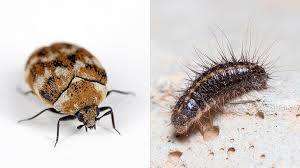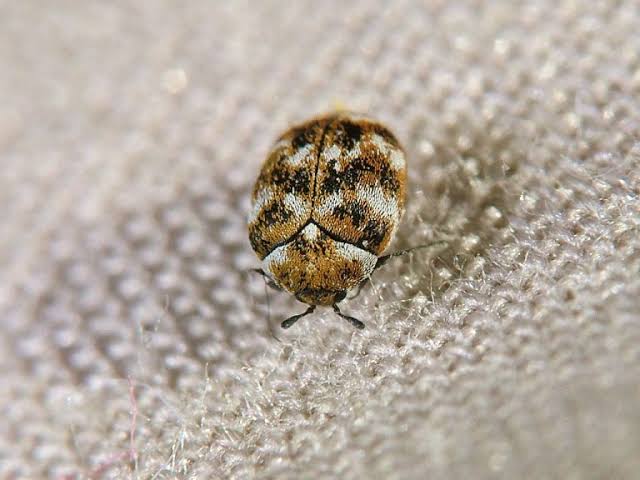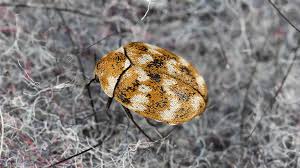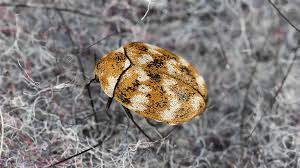Carpet beetles, scientifically known as Anthrenus verbasci, are tiny insects that often go unnoticed in homes. These little pests might not grab your attention at first, but their impact can be significant.
These beetles have a varied diet, and unfortunately for homeowners, that includes items commonly found in households. Natural fibers like wool, silk, feathers, and even pet hair are some of their favorite snacks. They don’t discriminate much when it comes to dining on these materials, making them potential nuisances.
The life cycle of carpet beetles consists of four stages: egg, larva, pupa, and adult. The larvae are the most destructive phase, as they feed voraciously on organic matter, causing damage to carpets, clothing, and other items made of natural fibers. Detecting these pests early is crucial to prevent extensive harm.
Carpet beetles are attracted to light, which often leads them into homes. They find their way through openings like windows or gaps in doors. Once inside, they can quickly become unwelcome guests, causing damage to cherished belongings.
To control carpet beetle infestations, regular cleaning and vacuuming are essential. Removing dust, hair, and debris reduces the potential food sources for these pests. Additionally, storing clothing and other susceptible items in sealed containers can help protect them from carpet beetle damage.
Despite their tiny size, carpet beetles can pose a significant challenge for homeowners. Understanding their habits and taking preventive measures can go a long way in keeping these pests at bay, preserving the integrity of your belongings and maintaining a pest-free living environment.
Read Also: Inbreeding, Importance and It’s Effect in Pig Farming
Animals Affected by Carpet Beetles (Anthrenus verbasci)

Carpet beetles can impact various animals, especially those with fur, feathers, or other organic materials in their environment. Household pets, such as dogs and cats, may be affected as carpet beetle larvae feed on pet hair and dander. This can lead to skin irritation and discomfort for the animals.
Feathered pets, like birds, are also susceptible to carpet beetle damage. The larvae may target bird feathers in cages or nesting materials, posing a threat to the well-being of the avian companions.
Wildlife can also be affected when carpet beetles invade natural habitats. Insects play vital roles in ecosystems, and disruptions caused by carpet beetles can have cascading effects on local wildlife. For example, the damage to nests and feathers of birds in the wild can impact their ability to thrive and reproduce.
In agricultural settings, carpet beetles may affect livestock by targeting animal fibers such as wool or hair. Livestock housing areas with woolen or fabric components could provide a habitat for carpet beetles, potentially leading to discomfort and health issues for the animals.
While carpet beetles primarily target materials like wool, silk, and feathers, their presence can indirectly affect a range of animals, including both pets and wildlife. Implementing preventive measures and promptly addressing infestations can help safeguard the well-being of animals in various environments.
Damages Caused by Carpet Beetles

Carpet beetles can inflict significant damage on various items within homes and other environments. Their larvae, in particular, are voracious eaters and can target a wide range of organic materials. The damages caused by carpet beetles include:
1. Clothing Damage: Carpet beetle larvae feed on natural fibers found in clothing, such as wool, silk, and fur. This can result in unsightly holes and damage to garments, potentially ruining clothing items.
2. Carpet and Upholstery Damage: As the name suggests, carpet beetles can wreak havoc on carpets and upholstered furniture. The larvae feed on the natural fibers in these items, leading to visible damage and deterioration.
3. Bedding and Linen Damage: Items like blankets, pillows, and bedspreads made from natural materials are susceptible to carpet beetle damage. Infestations can compromise the integrity of bedding, affecting both comfort and aesthetics.
4. Artifact and Taxidermy Damage: Museum collections and preserved specimens can suffer when carpet beetles invade. The larvae may consume natural materials used in artifacts or taxidermy specimens, leading to irreparable harm.
5. Book and Paper Damage: Carpet beetles can target paper products, including books, documents, and cardboard. Larvae feeding on paper materials can result in holes, damage to bindings, and the deterioration of valuable documents.
6. Pet-Related Damage: Carpet beetles can affect pets by feeding on their fur, feathers, or bedding. This can cause discomfort for animals and potentially lead to skin irritations.
7. Wildlife Nest Damage: In natural environments, carpet beetles may harm wildlife by damaging nests and feathers. This can impact the reproductive success and overall health of birds and other animals.
8. Food Contamination: While not direct feeders on food, carpet beetles can contaminate stored food products. They may leave behind shed skins, fecal pellets, or hairs, compromising the safety and quality of stored food items.
Addressing carpet beetle infestations promptly, implementing preventive measures, and maintaining a clean environment are crucial steps in minimizing the damages caused by these pests.
Read Also: Preparation Method and Uses of Pig Meat
Control and Preventive Measures

Controlling and preventing carpet beetle infestations involves a combination of proactive measures and targeted interventions. Here are some effective strategies:
1. Regular Cleaning: Thorough and regular cleaning of living spaces is crucial to remove potential food sources for carpet beetles. Vacuum carpets, upholstery, and drapes regularly, paying attention to corners and hidden areas.
2. Storage in Sealed Containers: Store clothing, linens, and other susceptible items in sealed plastic containers to prevent carpet beetles from accessing these materials. This also helps protect belongings from potential infestations.
3. Proper Food Storage: Keep food items in airtight containers to avoid attracting carpet beetles. Clean up crumbs and spills promptly, especially in kitchen areas.
4. Pet Grooming: Regular grooming of pets helps reduce the availability of pet hair and dander, minimizing potential food sources for carpet beetle larvae.
5. Natural Predators: Introduce natural predators of carpet beetles, such as predatory beetles or certain parasitic wasps, to control their population. This approach is more common in outdoor or agricultural settings.
6. Insecticides: Insecticides specifically formulated for carpet beetles can be used as a targeted measure. Apply these products to affected areas according to the manufacturer’s instructions.
7. Professional Pest Control: If infestations persist or are severe, seeking professional pest control services is advisable. Pest control experts can assess the situation and apply appropriate measures to eliminate carpet beetles.
8. Regular Inspections: Conduct regular inspections of areas prone to carpet beetle infestations, such as closets, attics, and storage spaces. Early detection allows for prompt intervention before significant damage occurs.
9. Maintain a Dry Environment: Carpet beetles thrive in humid conditions. Use dehumidifiers to maintain a dry indoor environment, especially in basements and other moisture-prone areas.
10. Limit Outdoor Entry Points: Seal cracks and gaps around windows, doors, and other entry points to prevent carpet beetles from entering the home.
Implementing a combination of these preventive measures and control strategies can effectively manage carpet beetle infestations, protecting your belongings and ensuring a pest-free living environment.
Frequently Asked Questions (FAQs) About Carpet Beetles (Anthrenus verbasci)
1. Q: What attracts carpet beetles to homes?
A: Carpet beetles are attracted to natural fibers such as wool, silk, and feathers. They enter homes seeking these materials, often drawn by light and warmth.
2. Q: Can carpet beetles damage synthetic fabrics?
A: While carpet beetle larvae prefer natural fibers, they may still damage synthetic fabrics if these materials are blended with natural fibers.
3. Q: How do I know if I have a carpet beetle infestation?
A: Look for small, fuzzy larvae, shed skins, or adult beetles in areas with natural fibers. Additionally, check for damage to clothing, carpets, and upholstery.
4. Q: Are carpet beetles harmful to humans?
A: Carpet beetles themselves are not harmful to humans. However, their larvae can cause skin irritation for some individuals.
5. Q: Can carpet beetles infest food?
A: While not direct feeders on food, carpet beetles can contaminate stored food items with shed skins, fecal pellets, or hairs.
6. Q: How do I get rid of carpet beetles naturally?
A: Natural methods include thorough cleaning, using essential oils like lavender or cedar, and introducing natural predators like predatory beetles.
7. Q: Do carpet beetles carry diseases?
A: No, carpet beetles are not known to carry or transmit diseases to humans.
8. Q: Can carpet beetles be controlled without using chemicals?
A: Yes, preventive measures like proper cleaning, sealing items in containers, and maintaining a dry environment can help control carpet beetles without relying on chemical interventions.
9. Q: Are carpet beetles seasonal pests?
A: Carpet beetles can be active year-round, but their activity may increase during warmer months.
10. Q: Can professional pest control effectively eliminate carpet beetles?
A: Yes, professional pest control services can assess the severity of the infestation and use targeted methods to eliminate carpet beetles effectively.
Read Also: Education, Entertainment Vital for Pupils

